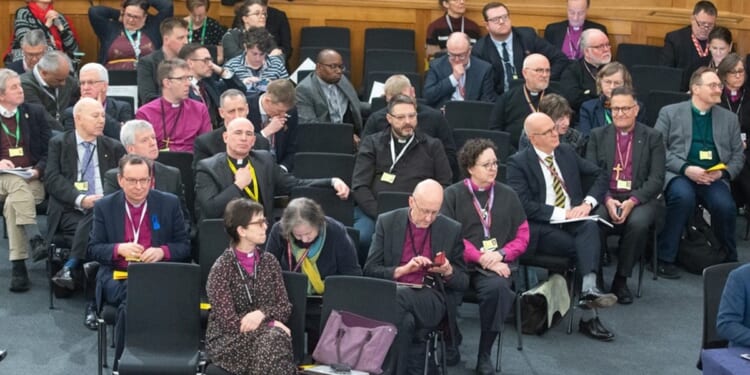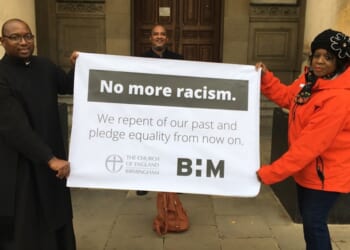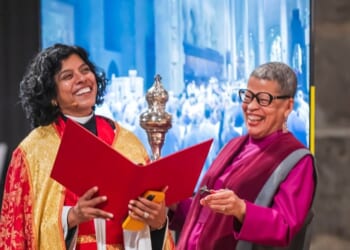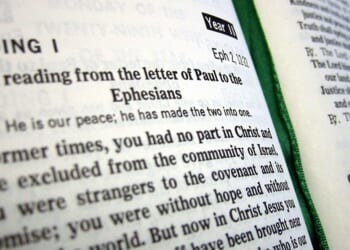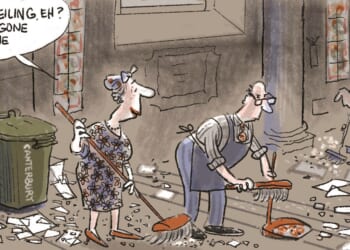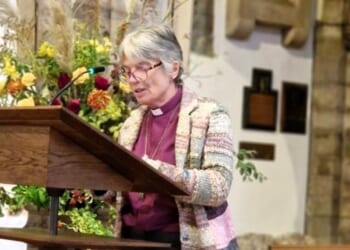A WARNING that the Prayers of Love and Faith (PLF) may have “a considerable unintended symbolic and theological impact” is among the cautionary notes sounded in a paper produced by the Faith and Order Commission (FAOC) to guide the Bishops’ deliberations on the future of the prayers.
The Doctrine of Marriage and the Prayers of Love and Faith: Texts and contexts was among the handful of early General Synod papers published last week before next February’s group of sessions.
The House of Bishops was provided with this paper — alongside two others by the Commission and new legal advice — for its meeting in October, before announcing that bespoke services for the PLF would need to be approved through a formal synodical processes — the Canon B2 route (News,17 October). The Bishops also said that there would be no immediate change to the rule that the clergy should not enter into same-sex marriages.
The release of the papers has given rise to speculation about whether particular elements helped to bring about the Bishops’ decision. But the Church Times understands that concern about the fracturing of the Church played a large part. In February, the Synod was provided with a draft Code of Practice for Pastoral Reassurance through Delegated Episcopal Ministry (DEM).
The code was designed to “enable specific areas of episcopal ministry to be formally delegated from a diocesan bishop to an episcopal colleague” for “churches and ministers where clear theological differences on the use of the PLF are present”. Ordinands would be able to request a DEM bishop as their sponsoring and ordaining bishop, who could also license clergy and lay ministers and be involved in appointments.
Some had sought to go further, however. The Alliance — a network of church organisations opposed to the changes — had been encouraging incumbents to persuade their PCCs to pass a resolution stating that, if the Church of England moved forward with either stand-alone services or clergy same-sex marriage, the parish would take at least one of a set of actions: seeking “alternative episcopal oversight”, a decision to “reroute their diocesan financial contributions”, and moves to “encourage ordinands to participate in an orthodox vocations programme” (News, 17 October). The Church Times understands that these plans are now on hold.
In a pastoral letter after the October statement, the Bishop of Chelmsford, Dr Guli Francis-Dehqani, said that the provision set out in the draft code would have “moved us towards alternative or extended oversight, not on the basis of who a bishop is or what action they may have taken, but purely on the basis of the views they may hold. Arguably, that would have taken us to a level of such complexity that it would risk breaking the Anglican model entirely.”
In a diocese such as Chelmsford this would “risk fracturing our shared life, putting huge pressure on our Area Scheme and our desire to maintain levels of consistency and a common direction of travel”.
While several dioceses — Oxford and London — had put in place temporary provision, Chelmsford had not, and this was “the right thing to do”, she argued. “I sincerely hope that now, all those who are part of the Diocese will commit to respecting and loving one another across our differences and contributing to our shared life.”
It is understood that some bishops felt that the offer of DEM was already too great a concession, while the PLF were a relatively small gain. There was concern about “sleep-walking” into a new ecclesial set-up with far-reaching consequences, and there were questions about whether — regardless of the presence of a code — some would still seek a “third space”.
In a new book, Created for Love (Canterbury Press, 2025), the Rt Revd Vivienne Faull, who retired as Bishop of Bristol this year, writes that “the creation of separate structures or enclaves” has “demeaned women and will demean LGBTIQI+ folk”.
She writes: “However determined and generous the relationships of mutuality, the assured place and sacramental provision of the Five Guiding Principles have solidified and ossified separation. Other than under the leadership of the most
remarkable clergy and bishops, separate cultures have emerged, and bishops, particularly female bishops, find their ministries and identities undermined.”
The Bishops’ October statement says that, given that the B2 route has now been agreed, there is “currently no need” for a new code of practice. Many within the House had long supported the case for the B2 process — a view that was strengthened as disagreements within the Church grew.
In 2023, the Bishops introduced the PLF as “the fullest possible pastoral provision without changing the Church’s doctrine of Holy Matrimony for same-sex couples” (News, 20 January 2023).
The argument that, since they did not involve any change in doctrine, they did not require two-thirds majorities in a vote by Houses in the Synod was firmly supported by Archbishop Welby (News, 20 January 2023). In 2017, he had spoken of the need for “radical new Christian inclusion in the Church” — a pledge that raised expectations and demanded an outworking.
A note on the legal position attached to an update on Living in Love and Faith, published with the Synod papers in July 2024, stated that the pastoral provision offered by the PLF represented “a pastoral outworking for a time of uncertainty that respects the Church of England’s unchanged doctrine of marriage . . .
“In so far as making the PLF available for couples in an active sexual relationship does involve any departure from doctrine, it nevertheless does not involve a departure from doctrine ‘in any essential matter’.”
The new Doctrine of Marriage paper is more circumspect. It warns: “When the PLF are used publicly, and especially when they are used in a bespoke or occasional service, they may be seen by some to communicate ecclesial endorsement of a couple’s relationship as a whole, including its sexual dimension This is true even though the actual words avoid nuptial or sacramental formulae.”
The prayers “might seem to be a natural way to offer prayer to God in thanksgiving for a particular moment in a couple’s life”, it says. But they “may have a considerable unintended symbolic and theological impact, particularly when they occur in church buildings and are witnessed by congregations gathered specifically for that occasion”.
When it comes to use of the prayers in some churches, it warns that “what was intended as pastoral care may function as innovation. . . The risk is that pastoral discretion becomes doctrinal pluralism, without the theological safeguards of collective discernment. . . If liturgical practice is allowed to diverge from doctrinal principle, then the Church’s claim to be a confessing body — one that worships according to what it believes — may be placed in jeopardy.”
A separate paper setting out legal advice notes the presence of “significant dissent” among the Bishops with regard to commending the PLF. This may, it says, have an impact on court rulings about their lawful use. Commendation of forms of service has “conventionally been by the unanimous decision . . . of the House of Bishops”.
This week, bishops rejected any suggestion that they had resisted engaging with theological advice. But it is understood that some had not had time to fully read the FAOC papers before the meeting last month. The production of the papers has also had an impact on the Commission itself. The chair, Dr Robert Innes, has spoken of an agenda “dominated” by LLF. He warned last year that its staff were “really stretched” and that limited resources had been “squeezed” in recent years.
On Tuesday, the Bishop of Blackburn, the Rt Revd Philip North, said: “We knew that the conclusions we reached at the meeting in October would be incredibly painful for some, and they were made only after careful study of this very detailed work. Through it, we came to see that the changes that LLF proposes are so profound and far-reaching that they need a full synodical process and debate if they are not to result in division.
“In particular, many bishops were deeply concerned about the impact that such changes would make on the missional coherence of their dioceses. A principle of the Church from the very earliest days is episcopal leadership based on geography. To lose this would result in a Church splintered up into different groups with overlapping and confusing leadership structures, offering weakened ministry and service to the nation.”
Legal advice published alongside the FAOC papers sets out a provisional timetable for the authorisation of bespoke PLF services through the B2 route. According to this, the current Synod would give first consideration to the Measure in February, but the process would then be passed to the newly elected Synod in 2027. The elections are to be held next summer. Inclusive Church and Together for the Church of England have already launched an election campaign.
Analysis, page 14; letters, page 15

